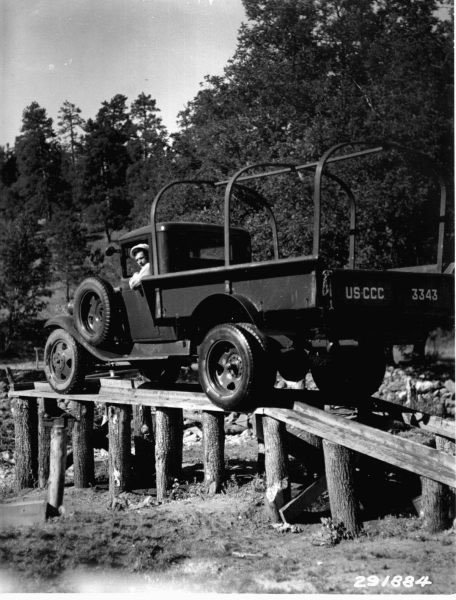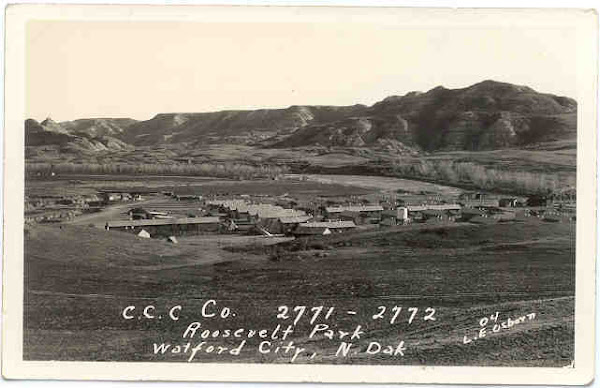 In my introductory post for this series I noted that I planned to rely heavily on Perry Merrill’s summary of benefits to the states in his book Roosevelt’s Forest Army and I’m sticking to that plan, especially in the case of CCC work in the District of Columbia, which is difficult to research on a good day.
In my introductory post for this series I noted that I planned to rely heavily on Perry Merrill’s summary of benefits to the states in his book Roosevelt’s Forest Army and I’m sticking to that plan, especially in the case of CCC work in the District of Columbia, which is difficult to research on a good day.For all of its seeming geographic insignificance, the District of Columbia
 (“DC”) was worthy of two CCC camps according to Merrill and an astounding 11,470 DC men were given employment as a result of the CCC (to say nothing of the many, many politicians who managed to keep getting reelected to at least some degree because of their votes in favor of funding the CCC). A partial statistical breakdown of CCC accomplishments in DC include construction of 20 bridges, 47 camp stoves and fireplaces, 94 table and bench combinations and over 76,000 linear feet of pipe, tile lines and conduit for flood control.
(“DC”) was worthy of two CCC camps according to Merrill and an astounding 11,470 DC men were given employment as a result of the CCC (to say nothing of the many, many politicians who managed to keep getting reelected to at least some degree because of their votes in favor of funding the CCC). A partial statistical breakdown of CCC accomplishments in DC include construction of 20 bridges, 47 camp stoves and fireplaces, 94 table and bench combinations and over 76,000 linear feet of pipe, tile lines and conduit for flood control.As was already mentioned, specific information regarding the work of the CCC in the District of Columbia is difficult to come by. The CCC Legacy Camp List does not include the District of Columbia, or Alaska or Hawaii. The list does indicate that DC was located in the Third Corps area along with Pennsylvania, Maryland, and Virginia.
Merrill refers to two specific CCC work projects in DC: the National Arboretum and Rock Creek Park. At the moment the website for the National Arboretum contains just one passing reference to the CCC, in an article about botanist Oliver Freeman. (You can see that article here.) There is a reference to the National Arboretum in Chapter 5 of the National Park Service Administrative History of the CCC. It seems that a company of black enrollees was selected to march in President Roosevelt’s 1937 inaugural parade. As for Rock Creek Park, you’ll find an all too brief reference to the CCC in the Administrative History of Rock Creek Park. Indeed, it’s brief enough that I’ll quote it at length here:
A Civilian Conservation Corps contingent then occupied the site (Camp Good Will), designated Camp NP-14, Rock Creek Park. Before and during its use of the area, the CCC performed a range of improvements in the park and Rock Creek and Potomac Parkway. Its enrollees cleared the creek channel and stabilized its banks with riprap, planted trees and shrubs, built more than two miles of bridle path with log hurdles for jumping, and constructed an addition to the Park Police lodge, which had been built with a $13,500 public works allotment on Beach Drive below Joyce Road in 1936.
Believe it or not, the Annual Reports do list enrollment figures for the District of Columbia, so given a lack of other detailed information on the work of the CCC in Washington, D.C., I’ll post the monthly enrollment figures for 1937 and 1939.
The 1937 Annual Report of the Director of Emergency Conservation Work listed the monthly enrollee totals for the District of Columbia for fiscal year 1937 as follows:
July 1936: 845
August 1936: 755
September 1936: 656
October 1936: 850
November 1936: 811
December 1936: 753
January 1937: 1,008
February 1937: 908
March 1937: 680
April 1937: 856
May 1937: 776
June 1937: 704
Average: 800/month
Two years later the numbers aren’t vastly different. The 1939 Annual Report of the Director the Civilian Conservation Corps listed the total number of CCC enrollees who enrolled in the CCC from the District of Columbia as:
July 1938: 822
August 1938: 778
September 1938: 700
October 1938: 858
November 1938: 804
December 1938: 735
January 1939: 916
February 1939: 892
March 1939: 645
April 1939: 853
May 1939: 809
June 1939: 661
Average: 789/month
So, in fiscal year 1937, an average of 800 CCC enrollees hailed from the District of Columbia on a month-to-month basis. In fiscal year 1939 that monthly average slipped slightly to 789 enrollees per month, and for some reason January was the enrollment high water mark both years. I’ve noted elsewhere in this series that CCC enrollment figures ebbed and flowed in response to a number of factors; for example in areas where annual crops were gathered, it is often found that local enrollment in CCC camps dropped off right about the time that workers were needed to bring in that year’s harvest. It’s intriguing to consider why enrollment in Washington D.C. suddenly spiked in January of 1937 and 1939.
 Certainly, the National Arboretum seems to have been the primary CCC work site (the camp was designated NA-1) in the District of Columbia and you’ll find a complimentary few paragraphs are devoted to that work in the 1942 Annual Report of the Civilian Conservation Corps (fiscal year 1942). Here are the details from that report in a section titled Plant Industry and the CCC:
Certainly, the National Arboretum seems to have been the primary CCC work site (the camp was designated NA-1) in the District of Columbia and you’ll find a complimentary few paragraphs are devoted to that work in the 1942 Annual Report of the Civilian Conservation Corps (fiscal year 1942). Here are the details from that report in a section titled Plant Industry and the CCC:Two CCC camps were assigned to the Bureau of Plant Industry. One of these, within the District of Columbia, since 1934, has been doing preliminary improvement and construction work for a national arboretum. The other at Cheyenne, Wyoming, started in 1935, has been working at a federal horticultural field station.
The national Arboretum is located in Northeast Washington just off the Bladensburg Road. The CCC company did a large amount of permanent work, all essential to the main purpose of the Arboretum. This camp came to the Arboretum in 1934 and was closed on December 15, 1941.

Much of the Arboretum land is in an early stage of development, and the camp contributed very substantially in this basic development work. Construction of roads, drainage, water systems, and fencing have been of primary importance. The fencing of the entire tract of some 400 acres with strong, high and permanent wire fence, with concrete curbing, was one of the outstanding CCC jobs. Five pithouses and a combination heating plant and potting shed were constructed by CCC labor. Important landscape projects have been the construction of three ponds and extensive grading in certain areas. Much soil perperation (sic) and planting of trees and shrubs was done. At this particular stage in the development of the National Arboretum the CCC work was decidedly a major contribution.
Given the glowing summary of the CCC’s work at the National Arboretum, it seems a bit sad that their current website doesn’t include any history on camp NA-1. Perhaps as we approach the 80th anniversary of the creation of the CCC in 2013, the folks at the National Arboretum will discover some of their own history and share it with the rest of us.
(Perhaps it is a commentary on the lack of available information on the work of the CCC in D.C. that there are no maps or photos of CCC work there that I have been able to track down. I’m sure they are out there somewhere.)












 (above) Foreman Bill Rutherford with his crew, Norwood, Colorado. (below) the CCC camp at Idaho Springs, Colorado.
(above) Foreman Bill Rutherford with his crew, Norwood, Colorado. (below) the CCC camp at Idaho Springs, Colorado.


 (Sources: The Colorado state map is taken from Cohen's Tree Army. Images from Colorado National Monument and Mesa Verde are from the book With Picks, Shovels and Hope. The contemporary image of the camp at Morrison, Colorado and the text of Lt. Neely's letter are from the Red Rocks visitor center exhibit. The company histories were taken from the 1936 District Annual. The image of the Idaho Springs CCC camp is from the Colorado State Archives, item number 30255 FF-6.)
(Sources: The Colorado state map is taken from Cohen's Tree Army. Images from Colorado National Monument and Mesa Verde are from the book With Picks, Shovels and Hope. The contemporary image of the camp at Morrison, Colorado and the text of Lt. Neely's letter are from the Red Rocks visitor center exhibit. The company histories were taken from the 1936 District Annual. The image of the Idaho Springs CCC camp is from the Colorado State Archives, item number 30255 FF-6.)









